Gerald Durrell titled his autobiographical book “My Family and Other Animals”.
This is a story about how we took our family to see the wonderful country that is Kenya, meet its people, enjoy its scenery and experience seeing the wild animals in their natural environment.
From a very early age we have mentioned Africa to our Grandchildren. First as bedtime stories, then as they learned to read they read the stories themselves and Africa also featured in conversation.
They then learned more about Africa through television, films and the theatre with titles such as “Lion King”.
My wife, Linda, often told them that one day we would take them to Africa so they could really see what we were talking about.
In the summer of 2022 the Grandchildren were 12, 9 and 8 and we decided they were now old enough to appreciate the experience and as we were in our mid 70s we were still fit enough to go so we decided it was time to ‘make a memory’.
Our good friend Sally’s son Chris was Oasis, the overlanding company, and had a lot of experience travelling in Africa so the first stage was to talk to him and put together a provisional itinerary. Chris told us about Often in Africa so the next stage was to contact Often with our proposal.
I corresponded with Often’s son Lonick and the first priority was to fix the dates by booking the tickets to fly to Kenya. Although the planned safari was still half a year away getting started early was essential as accommodation and attractions soon filled up, especially over the Christmas period. I contacted Sadie, a friend with a travel agency in Chippenham, and Pebbles arranged the flights. The dates were tricky as our daughters and their husbands businesses were busy in the weeks leading up to Christmas, especially Cracking Nuts who were flat out with Christmas orders, and the Grandchildren need to be back in time for school. Pebbles booked flights with Kenya Airways, leaving Heathrow on Christmas Day, which saved us something like 20% for the flights. Although this meant that Christmas Day was spent travelling to and waiting in Heathrow Airport, the Grandchildren ‘took it in their stride’ as they were so excited to be travelling to Africa.
Dawn was breaking as we arrived at Jomo Kenyatta International Airport. A suitable analogy for our safari. It appears that luck was with us from the beginning as we saw three Black Rhino near the road on our way from the airport. We were too early to check into the Wildebeest Eco Camp so we stopped at Java House in Karen for breakfast. Here we were made very welcome and karibu (welcome) became a word we encountered everywhere on our travels. This was a local establishment with local food used by the local people, so we were already absorbing the culture and bonding with our hosts, Often, Lonick and Alex.
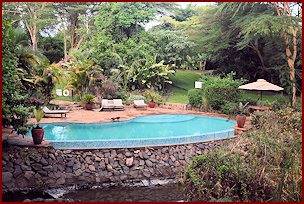 We were again greeted with “karibu” and made to feel very welcome when we arrived at Wildebeest Eco Camp . The Grandchildren were immediately attracted to the open air swimming pool whilst we could watch the Weaver birds building their nests and a Kingfisher looking for a meal from the comfort of the decking enjoying a cup of tea or a beer. Did we really fly the Grandchildren 4000 miles to go swimming? You can
We were again greeted with “karibu” and made to feel very welcome when we arrived at Wildebeest Eco Camp . The Grandchildren were immediately attracted to the open air swimming pool whilst we could watch the Weaver birds building their nests and a Kingfisher looking for a meal from the comfort of the decking enjoying a cup of tea or a beer. Did we really fly the Grandchildren 4000 miles to go swimming? You can 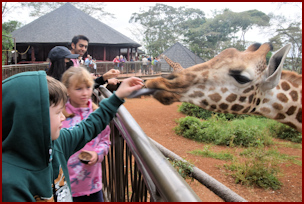 look around the Wildebeest Eco Camp with this 360° Panoramic Tour by the Hotlist Group. The plan was to rest up after our flight then visit the Giraffe Centre at Langata, but it was Boxing Day and it was jam-packed with visitors so, at our hosts suggestion, we visited the Kenyatta International Convention Centre where we had a bird’s eye view of Nairobi City from the top of the tower. We were up early next morning and back to the Giraffe Centre, which we had almost to ourselves and were able to feed and get up close to these wild animals and experience the roughness of their tongues. Whilst at the centre Lonick and Alex organised an interesting and informative talk about the centre and the giraffe by one of the guides. Travelling with Often in Africa meant flexibility. In the afternoon we attempted to visit the Ngong Hills, but ‘the heavens opened’ with much need heavy rain, but this was still part the adventure as it showed the Grandchildren how the torrential rain can quickly make the earth roads impassable, even to four wheel drive vehicles.
look around the Wildebeest Eco Camp with this 360° Panoramic Tour by the Hotlist Group. The plan was to rest up after our flight then visit the Giraffe Centre at Langata, but it was Boxing Day and it was jam-packed with visitors so, at our hosts suggestion, we visited the Kenyatta International Convention Centre where we had a bird’s eye view of Nairobi City from the top of the tower. We were up early next morning and back to the Giraffe Centre, which we had almost to ourselves and were able to feed and get up close to these wild animals and experience the roughness of their tongues. Whilst at the centre Lonick and Alex organised an interesting and informative talk about the centre and the giraffe by one of the guides. Travelling with Often in Africa meant flexibility. In the afternoon we attempted to visit the Ngong Hills, but ‘the heavens opened’ with much need heavy rain, but this was still part the adventure as it showed the Grandchildren how the torrential rain can quickly make the earth roads impassable, even to four wheel drive vehicles.
Next morning the sun came out and our next destination was Naivasha. We travelled north along the top of the eastern wall of Africa’s Great Rift Valley stopping at a viewpoint on the escarpment to look across this this great scar on the earth’s surface with the volcanic cones of Suswa to the left and Longonot to the right.

We wound down the escarpment passing the little church built by Italian prisoners of war near the bottom and made our way to Fisherman’s Camp on the shore of Lake Naivasha passing a multitude of polytunnels growing roses for shipment to the Netherlands as is the case in Bahir Dar in Ethiopia. 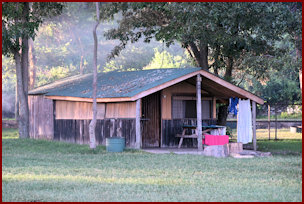 Lunch at Fisherman’s Camp was a protracted affair for some reason. Lonick and Alex had arranged for a local guide, Simon, to take us by boat to Elsamere at 2 pm but it was 3 pm before we eventually started our journey. The bird life at Fisherman’s Camp and along the lake shore was amazing and included Fish Eagles, Ibis, Hamerkop Storks, Herons, Woodpeckers, Cormorants, Lilac-breasted Rollers (the national bird of Kenya) just to name a few and we saw many birds and a score of Hippopotamus on our boat trip to Elsamere with its resident Colobus Monkeys, but the Grandchildren were more interested in watching a dung beetle struggling to make progress through the grass where every blade presented an obstacle. At Elsamere we learned about Joy and George Adamson and the lioness Elsa. As a result of our protracted lunch we had dinner at the nearby Camp Carnelley’s and used this venue for our remaining meals whilst in Naivasha.
Lunch at Fisherman’s Camp was a protracted affair for some reason. Lonick and Alex had arranged for a local guide, Simon, to take us by boat to Elsamere at 2 pm but it was 3 pm before we eventually started our journey. The bird life at Fisherman’s Camp and along the lake shore was amazing and included Fish Eagles, Ibis, Hamerkop Storks, Herons, Woodpeckers, Cormorants, Lilac-breasted Rollers (the national bird of Kenya) just to name a few and we saw many birds and a score of Hippopotamus on our boat trip to Elsamere with its resident Colobus Monkeys, but the Grandchildren were more interested in watching a dung beetle struggling to make progress through the grass where every blade presented an obstacle. At Elsamere we learned about Joy and George Adamson and the lioness Elsa. As a result of our protracted lunch we had dinner at the nearby Camp Carnelley’s and used this venue for our remaining meals whilst in Naivasha.
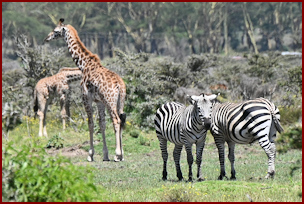
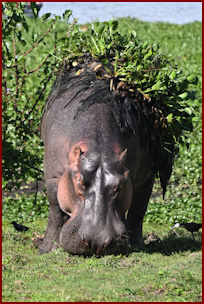 Next morning Simon took us on a walking safari and it was a case of “Simon says” was for real and not just a game as we walked through the bush amongst the Zebra and Impala and walked past a herd of Cape Buffalo fortunately relaxing under the trees then into an area where we were with the Giraffe and Baboons. Back into the vehicles to go to a volcanic crater. After climbing up to the rim we then walked down into the crater to enjoy lunch on a floating deck on the lake in the crater at Crater Lake Camp. After lunch it was back to Fisherman’s Camp where a Hippo was nochantly grazing on the strip of land between the camp and the lake.
Next morning Simon took us on a walking safari and it was a case of “Simon says” was for real and not just a game as we walked through the bush amongst the Zebra and Impala and walked past a herd of Cape Buffalo fortunately relaxing under the trees then into an area where we were with the Giraffe and Baboons. Back into the vehicles to go to a volcanic crater. After climbing up to the rim we then walked down into the crater to enjoy lunch on a floating deck on the lake in the crater at Crater Lake Camp. After lunch it was back to Fisherman’s Camp where a Hippo was nochantly grazing on the strip of land between the camp and the lake.
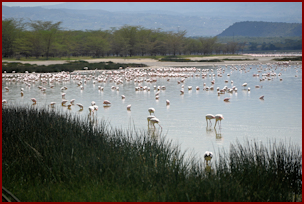 Our next destination was Nakuru, but we stopped on the shores of Lake Elementaita at Sirville Lake Elementaita Lodge to see the multitude of Flamingos and where the Grandchildren enjoyed swimming in the open air pool. Other bird life included
Our next destination was Nakuru, but we stopped on the shores of Lake Elementaita at Sirville Lake Elementaita Lodge to see the multitude of Flamingos and where the Grandchildren enjoyed swimming in the open air pool. Other bird life included 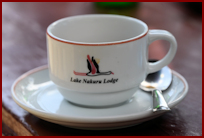 Pelicans and a Spoonbill. This stop was suggested by Lonick when we were planning the safari with Often in Africa and proved fortuitous as the waters of Lake Nakuru have risen considerably during the last few years with heavy rains which has diluted the waters of the lake making it less attractive to the flamingo population.
Pelicans and a Spoonbill. This stop was suggested by Lonick when we were planning the safari with Often in Africa and proved fortuitous as the waters of Lake Nakuru have risen considerably during the last few years with heavy rains which has diluted the waters of the lake making it less attractive to the flamingo population.![]()
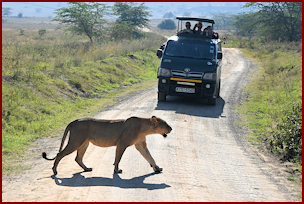
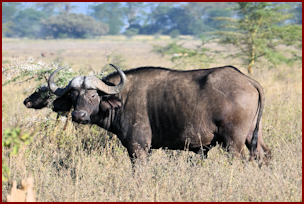 Our accommodation in Nakuru was two nights at Punda Milias where the Grandchildren enjoyed swimming in yet another open air pool. Next morning it was an early start as we entered through Lanet Gate to visit Lake Nakuru National Park where we were soon seeing the animals in their natural environment. Lonick and Alex opened the roofs of their vehicles enhancing the adventure, especially for the Grandchildren who could move about inside the cars without being told to sit in their seats with their seat belts on. The vehicles were fitted with radios so Alex and Lonick were able to chat to others in the park so we were able to go where the animals were.
Our accommodation in Nakuru was two nights at Punda Milias where the Grandchildren enjoyed swimming in yet another open air pool. Next morning it was an early start as we entered through Lanet Gate to visit Lake Nakuru National Park where we were soon seeing the animals in their natural environment. Lonick and Alex opened the roofs of their vehicles enhancing the adventure, especially for the Grandchildren who could move about inside the cars without being told to sit in their seats with their seat belts on. The vehicles were fitted with radios so Alex and Lonick were able to chat to others in the park so we were able to go where the animals were. 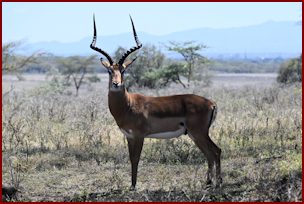
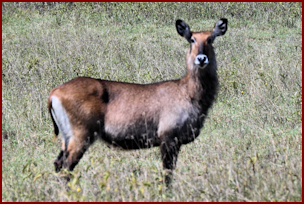 Their local knowledge was also invaluable and it was not long before two Lionesses were walking along the road between the cars. More radio communication led us to Nuya Causeway where we saw a very large Rock Python. At first we could see nothing then gradually we could make out its nostrils above the water and its huge body lurking in the brown water. This was definitely a sight we would have missed without the knowledge and experience that Lonick and Alex brought to our safari. The bird life was abundant in the reserve as were animals such as Zebra and Antelope. Lunch in the Lake Nakuru National Park was a picnic at the Makalia Falls Viewpoint where we were able to walk to and admire the falls.
Their local knowledge was also invaluable and it was not long before two Lionesses were walking along the road between the cars. More radio communication led us to Nuya Causeway where we saw a very large Rock Python. At first we could see nothing then gradually we could make out its nostrils above the water and its huge body lurking in the brown water. This was definitely a sight we would have missed without the knowledge and experience that Lonick and Alex brought to our safari. The bird life was abundant in the reserve as were animals such as Zebra and Antelope. Lunch in the Lake Nakuru National Park was a picnic at the Makalia Falls Viewpoint where we were able to walk to and admire the falls.
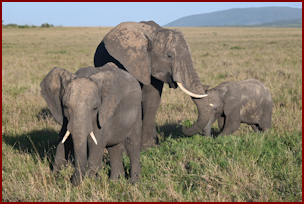
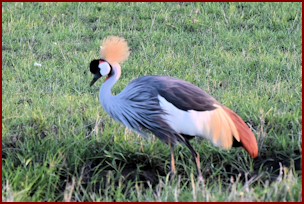 After our stay at Punda Milias our next destination was the Maasai Mara. We set off from Nakuru and climbed the western wall of the Great Rift Valley to the farms in the Mau Narok area reaching an altitude of over 9000 feet above sea level then down to the Maasai Mara which is still some 5000 to 6000 feet above sea level. Here Lonick had booked us in to the Mountain Rock Mara Springs camp. We quickly settled in and were soon off into the Mara for an afternoon game drive. It was not long before we encountered Elephants, Lions, Gazelle and even Crowned Cranes. Up early next morning to make the most of visiting this magical place. The reserve is the domain of the animals.
After our stay at Punda Milias our next destination was the Maasai Mara. We set off from Nakuru and climbed the western wall of the Great Rift Valley to the farms in the Mau Narok area reaching an altitude of over 9000 feet above sea level then down to the Maasai Mara which is still some 5000 to 6000 feet above sea level. Here Lonick had booked us in to the Mountain Rock Mara Springs camp. We quickly settled in and were soon off into the Mara for an afternoon game drive. It was not long before we encountered Elephants, Lions, Gazelle and even Crowned Cranes. Up early next morning to make the most of visiting this magical place. The reserve is the domain of the animals. 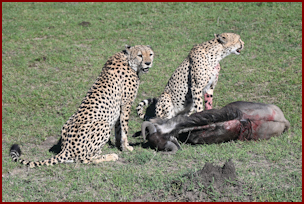
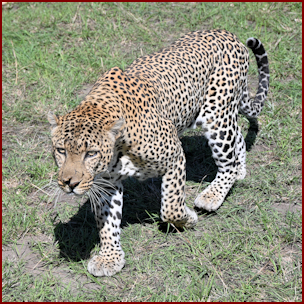 This is their natural environment so you never know what you will see. We had not been in the park long before we spotted a young lone Wildebeest. It should not have been in the Mara as it should have migrated to the Serengeti weeks before. Alex and Lonick brought our attention to two Cheetah crouching in the long grass some distance away. Suddenly they were up, speeding across the savanna. The Wildebeest set off at great pace but was no match for the speed of the Cheetahs, but it took the two of them some minutes to despatch the struggling Wildebeest after they had caught it. We were extremely fortunate to witness such an event, but was this really the kind of memory to make for our Grandchildren? They ‘took it in their stride’ commenting that it was ‘the circle of life’. The next surprise was to encounter a Leopard who took advantage of the shade offered by our vehicles.
This is their natural environment so you never know what you will see. We had not been in the park long before we spotted a young lone Wildebeest. It should not have been in the Mara as it should have migrated to the Serengeti weeks before. Alex and Lonick brought our attention to two Cheetah crouching in the long grass some distance away. Suddenly they were up, speeding across the savanna. The Wildebeest set off at great pace but was no match for the speed of the Cheetahs, but it took the two of them some minutes to despatch the struggling Wildebeest after they had caught it. We were extremely fortunate to witness such an event, but was this really the kind of memory to make for our Grandchildren? They ‘took it in their stride’ commenting that it was ‘the circle of life’. The next surprise was to encounter a Leopard who took advantage of the shade offered by our vehicles. 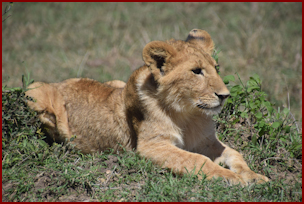 Other animals we saw included Crocodiles and Hippopotomous in the Mare River, Lions, Zebra, Giraffe, Gazelle, Rhinoceros, Elephants, Cape Buffalo and Impala.
Other animals we saw included Crocodiles and Hippopotomous in the Mare River, Lions, Zebra, Giraffe, Gazelle, Rhinoceros, Elephants, Cape Buffalo and Impala. 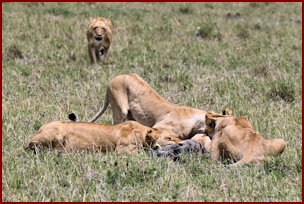 We had already seen more than expected, but the next day brought even more surprises. We had again not been in the reserve long when we came across five Lionesses in an arc hunting Warthogs with a sixth on the other side herding them towards the other Lionesses. We were now witnessing a Lion hunt! One of the Lionesses in the arc was even using the vehicles as cover. The Grandchildren had seen Africa as it really is. The myth in “Lion King” that Warthogs and Lions could be mates was exploded as the Lionesses caught not one, but two Warthogs.
We had already seen more than expected, but the next day brought even more surprises. We had again not been in the reserve long when we came across five Lionesses in an arc hunting Warthogs with a sixth on the other side herding them towards the other Lionesses. We were now witnessing a Lion hunt! One of the Lionesses in the arc was even using the vehicles as cover. The Grandchildren had seen Africa as it really is. The myth in “Lion King” that Warthogs and Lions could be mates was exploded as the Lionesses caught not one, but two Warthogs. 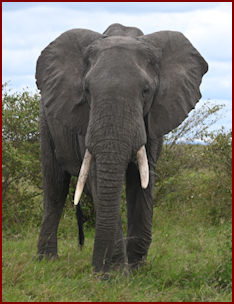 The adventure was not just about the animals, but about the country and its people so the next event was to visit a Maasai village and see a way of life that even the books they read cannot really get across. Returning to the Mountain Rock Mara Springs camp we had an impromptu football match with some of the staff, which rounded off our safari in an unexpected way. Our journey back to Nairobi and the Wildebeest Eco Camp took us back down onto the floor of the Great Rift Valley and we passed between the volcanic cones of Suswa to our right and Longonot to our left before climbing the escarpment up the eastern wall of the Rift Valley.
The adventure was not just about the animals, but about the country and its people so the next event was to visit a Maasai village and see a way of life that even the books they read cannot really get across. Returning to the Mountain Rock Mara Springs camp we had an impromptu football match with some of the staff, which rounded off our safari in an unexpected way. Our journey back to Nairobi and the Wildebeest Eco Camp took us back down onto the floor of the Great Rift Valley and we passed between the volcanic cones of Suswa to our right and Longonot to our left before climbing the escarpment up the eastern wall of the Rift Valley.
We had set out to ‘make a memory’, but I wonder what that memory will be, especially for the Grandchildren. Will it be the open air swimming pools or being freely allowed to wander around the vehicles while travelling on unmade roads? Hopefully the memories will include the wild life adventures, the landscape and the encounter with the people of Kenya and our hosts. Often in Africa made this a memorable experience and it was a sad moment when we had to say kwaheri to Often, Lonick and Alex who we had now regarded as friends.
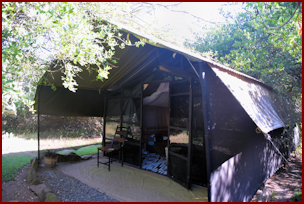
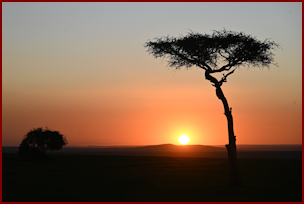 Our accommodation was large comfortable tents at Wildebeest Eco Camp, Punda Milias and Mountain Rock Mara Springs and a wooden cabin at Fisherman’s Camp. All had en-suite facilities including a washbasin, shower, flushing toilet and hot water, if you were patient and waited for it to travel from the boiler.
Our accommodation was large comfortable tents at Wildebeest Eco Camp, Punda Milias and Mountain Rock Mara Springs and a wooden cabin at Fisherman’s Camp. All had en-suite facilities including a washbasin, shower, flushing toilet and hot water, if you were patient and waited for it to travel from the boiler.
Cash flow was a challenge as we were a party of nine and each venue and activity was paid for at the time. Some venues accepted Credit Cards and some only Cash. Some accepted US$ for Cash, but some only accepted Kenya Shillings (KSh) so it is useful to know who accepts what before travelling and Often in Africa helped with this information.
Cash was readily available from ATMs, but I found I was limited to US$ 300 or KSh 35,500 per Card. The ATMs in Nairobi and Narok dispensed both US$ and KSh, but the ATMs in Naivasha and Nakuru only dispensed KSh. The ATMs accepted Visa, both Credit and Debit Cards, and Mastercard, including FairFX, but the only place I found that accepted American Express was Lake Nakuru National Park.
Park entrance fees are a major expense at US$70 per adult and US$40 per child (under 12) per day (December 2022). Whilst the Lake Nakuru National Park accepted Credit Cards, the Maasai Mara Reserve required payment in US$.
The Wildebeest Eco Camp was a great place to purchase souvenirs as their prices were displayed and reasonable. We found that the ‘Curio Centres’ did not display prices so the prices were ‘negotiable’ and often started very high.

